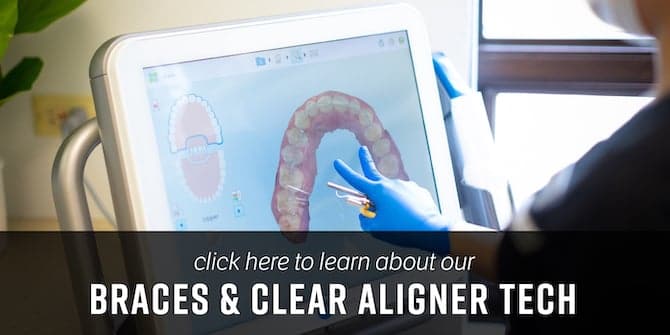How Braces Can Help TMJ Pain
Experiencing pain in your mouth, jaw and ears can be quite unpleasant. Particularly when dealing with TMJ (Temporomandibular joint) pain, which can last anywhere from a few weeks to several years. At Advanced Orthodontic Specialists, we empathize with your concern and understand that when it comes to issues involving your jaw or mouth, you’re eager to gain clarity about the underlying causes and find effective solutions to alleviate the pain. That’s why we’re talking about how braces can help TMJ pain!
What Causes TMJ Pain?
First off let’s address what TMJ stands for, which are the temporomandibular joints. Temporomandibular joints are the joints that act like hinges that connect your jawbone to the temporal bones, which is the area in front of each ear. Temporomandibular disorders or TMD (temporomandibular joint disorder) is when there is pain, discomfort, or dysfunction with your TMJ and surrounding muscles.
Temporomandibular disorder can stem from several possible causes. One of the most common causes is the habit of teeth grinding or clenching, which puts significant stress on the temporomandibular joint. TMD can also be prompted by conditions such as arthritis, which affects the joint, or heightened stress levels that result in increased tension in the jaw and facial muscles.
It’s worth noting that a jaw injury, such as a dislocated or broken jaw, can also lead to this kind of pain, as can misaligned teeth.
What are TMJ Symptoms & Who Does TMJ Pain Happen To?
Temporomandibular disorder can lead to significant and prolonged discomfort and pain. This pain can manifest on one side of the face or can impact both sides. TMD predominantly affects individuals between the ages of 20 to 40, with a higher prevalence among women compared to men.
Temporomandibular disorder symptoms can vary, with some even impacting the ear, neck, and shoulder.
One of the most common symptoms is sensitivity and tenderness in the facial and jaw joint areas. Discomfort and pain tend to escalate during activities like chewing, speaking, or when the mouth is opened widely. Some individuals may even grapple with locked jaws, where the jaw gets stuck in either an open or closed position. Additionally, clicking or popping sounds can accompany jaw movement when opening and closing the mouth. Other common symptoms of TMD include:
- abrupt discomfort while biting or chewing
- a sensation that the upper and lower teeth or jaw are not aligning correctly.
- headaches associated with TMD
- swelling
How Can Braces Help with TMJ Pain?
Many TMJ symptoms are exaggerated by dental problems that can be easily addressed with orthodontic treatment. Braces and aligners can be a great addition to TMD treatment by addressing certain underlying causes of TMJ pain, such as open bites and crossbites. Misaligned teeth, a common factor in TMD, can lead to teeth grinding and clenching as patients subconsciously attempt to compensate for the misalignment. Whether you opt for traditional braces, Invisalign™ or SparkTM aligners, they can play a pivotal role in rectifying crossbites, open bites, and misaligned bites. By doing so, these orthodontic treatments can be helpful in the treatment of TMD symptoms.
We are committed to not only identifying the source of your discomfort, but also offering comprehensive and timely solutions to address it. Our team of experienced professionals at Advanced Orthodontic Specialists are dedicated to ensuring that you receive the highest level of care and that your journey to a pain-free, healthy mouth and jaw is as efficient and comfortable as can be. Your well-being is our priority, and our TMJ doctors are here to guide you through the process with care and expertise to resolve your TMJ pain.





